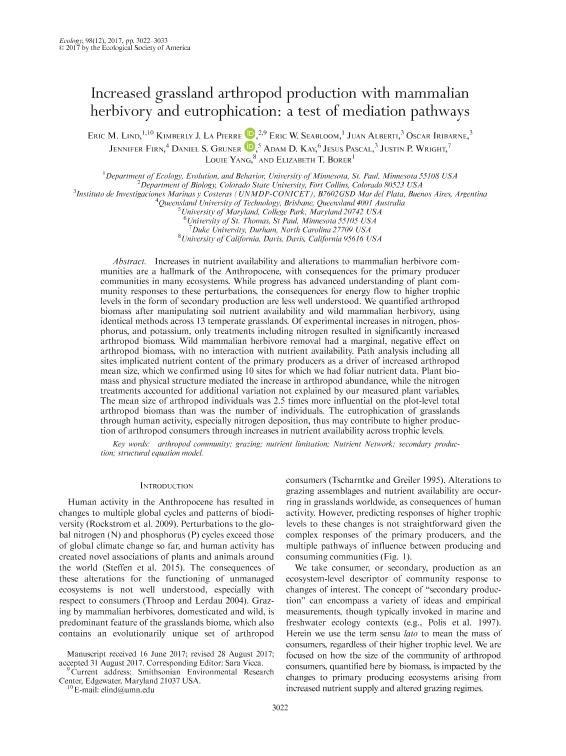Mostrar el registro sencillo del ítem
dc.contributor.author
Lind, Eric M.
dc.contributor.author
La Pierre, Kimberly J.
dc.contributor.author
Seabloom, Eric W.
dc.contributor.author
Alberti, Juan

dc.contributor.author
Iribarne, Oscar Osvaldo

dc.contributor.author
Firn, Jennifer

dc.contributor.author
Gruner, Daniel S.
dc.contributor.author
Kay, Adam D.
dc.contributor.author
Pascual, Jesus Maria

dc.contributor.author
Wright, Justin P.
dc.contributor.author
Yang, Louie
dc.contributor.author
Borer, Elizabeth T.
dc.date.available
2018-08-22T18:30:54Z
dc.date.issued
2017-12
dc.identifier.citation
Lind, Eric M.; La Pierre, Kimberly J.; Seabloom, Eric W.; Alberti, Juan; Iribarne, Oscar Osvaldo; et al.; Increased grassland arthropod production with mammalian herbivory and eutrophication: a test of mediation pathways; Ecological Society of America; Ecology; 98; 12; 12-2017; 3022-3033
dc.identifier.issn
0012-9658
dc.identifier.uri
http://hdl.handle.net/11336/56632
dc.description.abstract
Increases in nutrient availability and alterations to mammalian herbivore communities are a hallmark of the Anthropocene, with consequences for the primary producer communities in many ecosystems. While progress has advanced understanding of plant community responses to these perturbations, the consequences for energy flow to higher trophic levels in the form of secondary production are less well understood. We quantified arthropod biomass after manipulating soil nutrient availability and wild mammalian herbivory, using identical methods across 13 temperate grasslands. Of experimental increases in nitrogen, phosphorus, and potassium, only treatments including nitrogen resulted in significantly increased arthropod biomass. Wild mammalian herbivore removal had a marginal, negative effect on arthropod biomass, with no interaction with nutrient availability. Path analysis including all sites implicated nutrient content of the primary producers as a driver of increased arthropod mean size, which we confirmed using 10 sites for which we had foliar nutrient data. Plant biomass and physical structure mediated the increase in arthropod abundance, while the nitrogen treatments accounted for additional variation not explained by our measured plant variables. The mean size of arthropod individuals was 2.5 times more influential on the plot-level total arthropod biomass than was the number of individuals. The eutrophication of grasslands through human activity, especially nitrogen deposition, thus may contribute to higher production of arthropod consumers through increases in nutrient availability across trophic levels.
dc.format
application/pdf
dc.language.iso
eng
dc.publisher
Ecological Society of America

dc.rights
info:eu-repo/semantics/openAccess
dc.rights.uri
https://creativecommons.org/licenses/by-nc-sa/2.5/ar/
dc.subject
Arthropod Community
dc.subject
Grazing
dc.subject
Nutrient Limitation
dc.subject
Nutrient Network
dc.subject
Secondary Production
dc.subject
Structural Equation&Nbsp;Model
dc.subject.classification
Otras Ciencias Biológicas

dc.subject.classification
Ciencias Biológicas

dc.subject.classification
CIENCIAS NATURALES Y EXACTAS

dc.title
Increased grassland arthropod production with mammalian herbivory and eutrophication: a test of mediation pathways
dc.type
info:eu-repo/semantics/article
dc.type
info:ar-repo/semantics/artículo
dc.type
info:eu-repo/semantics/publishedVersion
dc.date.updated
2018-08-21T13:46:43Z
dc.journal.volume
98
dc.journal.number
12
dc.journal.pagination
3022-3033
dc.journal.pais
Estados Unidos

dc.journal.ciudad
Washington
dc.description.fil
Fil: Lind, Eric M.. University of Minnesota; Estados Unidos
dc.description.fil
Fil: La Pierre, Kimberly J.. State University of Colorado - Fort Collins; Estados Unidos
dc.description.fil
Fil: Seabloom, Eric W.. University of Minnesota; Estados Unidos
dc.description.fil
Fil: Alberti, Juan. Consejo Nacional de Investigaciones Científicas y Técnicas. Centro Científico Tecnológico Conicet - Mar del Plata. Instituto de Investigaciones Marinas y Costeras. Universidad Nacional de Mar del Plata. Facultad de Ciencia Exactas y Naturales. Instituto de Investigaciones Marinas y Costeras; Argentina
dc.description.fil
Fil: Iribarne, Oscar Osvaldo. Consejo Nacional de Investigaciones Científicas y Técnicas. Centro Científico Tecnológico Conicet - Mar del Plata. Instituto de Investigaciones Marinas y Costeras. Universidad Nacional de Mar del Plata. Facultad de Ciencia Exactas y Naturales. Instituto de Investigaciones Marinas y Costeras; Argentina
dc.description.fil
Fil: Firn, Jennifer. Queensland University of Technology; Australia
dc.description.fil
Fil: Gruner, Daniel S.. University of Maryland; Estados Unidos
dc.description.fil
Fil: Kay, Adam D.. University of St. Thomas; Estados Unidos
dc.description.fil
Fil: Pascual, Jesus Maria. Consejo Nacional de Investigaciones Científicas y Técnicas. Centro Científico Tecnológico Conicet - Mar del Plata. Instituto de Investigaciones Marinas y Costeras. Universidad Nacional de Mar del Plata. Facultad de Ciencia Exactas y Naturales. Instituto de Investigaciones Marinas y Costeras; Argentina
dc.description.fil
Fil: Wright, Justin P.. University of Duke; Estados Unidos
dc.description.fil
Fil: Yang, Louie. University of California at Davis; Estados Unidos
dc.description.fil
Fil: Borer, Elizabeth T.. University of Minnesota; Estados Unidos
dc.journal.title
Ecology

dc.relation.alternativeid
info:eu-repo/semantics/altIdentifier/doi/https://dx.doi.org/10.1002/ecy.2029
dc.relation.alternativeid
info:eu-repo/semantics/altIdentifier/url/https://esajournals.onlinelibrary.wiley.com/doi/abs/10.1002/ecy.2029
Archivos asociados
